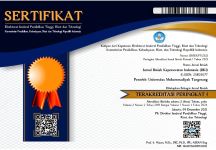PENGALAMAN KELUARGA MERAWAT PENDERITA KUSTA DALAM MENGHADAPI STIGMA MASYARAKAT DI KELURAHAN LIMO DEPOK - JAWA BARAT
Abstract
Penyakit kusta merupakan penyakit yang mengerikan bagi orang awam, karena kondisi tubuh dengan luka terbuka disertai kecacartan yang terjadi pada anggota tobuh, serta kondisi tubuh yang kotor.Gambaran tubuh penderita kusta yang mengerikan adalah alasan utama terjadi stigma sosial. Penderita kusta yang cacat tidak mampu bekerja dan mereka kehilangan pekerjaan mereka dan kemandirian ekonomi mereka. Selain itu, mereka kehilangan harga diri dan kualitas hidup sebagai akibat stigma. Tujuan penelitian ini adalah untuk mencari informasi tentang “Pengalaman Keluarga Merawat Penderita Kusta Dalam Menghadapi Stigma Masyarakat Di Kelurahan Limo Depok - Jawa Barat”. Penelitian ini merupakan penelitian deskritif kualitatif fenomenologi, dengan menggunakan analisa metode Colaizzi, yang dilakukan pada sembilan partisipan. Hasil analisis menunjukkan ada tiga tema utama yaitu pemahaman keluarga terhadap perawatan kusta,pengalaman keluarga penderita kusta dalam menghadapi stigma,dan pandangan terhadap stigma yang dihadapi karena ada anggota keluarga menderita kusta. Keluarga menjaga anggota keluarga yang menderita kusta dari stigma masyarakat dengan menutupi kondisi kesehatan tersebut. Masalah atau hambatan yang dialami keluarga dalam menghadapi stigma dari masyarakat ketika penderita mengalami perasaan sedih dan menyendiri. Keluarga berharap agar mendapatkan penyuluhan kesehatan dalam mencegah kecacatan pada penderita kusta. Hasil penelitian ini dapat menjadi acuan pelayanan kesehatan, keluarga dan pemerintah dalam mengeluarkan kebijakan untuk mengeliminasi penyakit kusta di Indonesia.
Kata Kunci: Colaizzi, Kusta, Stigma
Full Text:
Siregar_JIKIReferences
Abedi, H et al. (2013). An Exploration of Health, Family and Economic Experiences of leprosy Patients, Iran. Pakistan Journal of Biological Science. Vol 16. p 927
Ablon J. (2002) The nature of stigma and
medical conditions. Epilepsy
Behaviour Dec;3(6S2) p: 52-59.
Adhikari, Shrestha, Kahlesr, Raut, Chapman
(2013). Community Attitudes
towards Leprosy Affected Persons in
Pokhara Municipality of Western
Nepal. Jornal Nepal Health Res Counc
Vol 11 (25) Sep 2013
Anderson, ET & McFarlene, J. (2006) Community as Partner: Theory and Practice in Nursing. Ed. 1th. Amazone: Lippincot.
Bainson & Borne, B (1998). Dimensions and Process of Stigmazation in Leprosy. Leprosy Review. PubMed.gov. US National Library of Medicine National Institute of Health. Dec . 69 (4) p; 342- 350
Batson (2002) Empathy, Attitudes, and Action: Can Feeling for a Member of a Stigmatized Group Motivate One to Help the Group. Downloaded from psp.sagepub.com at Harvard Libraries on February 25, 2015 P: 1656 - 1666
Brouwers, C et al. (2011).Perceived Stigma Quality of Life, Activity and Participation of People With Leprosy-Related Disabilities in Sout-Eats Nepal. Disability, CBR and Inclusive Development, Vol 22, No. 1
Burns, et al. (2010). Rook’s Textbook of Dermatology. Eight Edition. United
kingdom: Wiley-Blackwell.
Burns, N. & Grove, S.K. (2009). The Practice of Nursing Research: Appraisal, Synthesis, and Generation of Evidence. 6th edition. St. Louis: Saunders Elsevier
Creswell, J.W. (2007). Qualitative Inquiry and Research Design.California :SagePublication.Inc.
Crosby (2012). Exploring Stigma, Idnentity Gaps, and Consumption. Disertation Doctor of Philosophy in Busness Adminstration University of Illionis at Urbana-Champaign
Das V. (2006). Stigma, Contagion, Defect: Issues in the Antropology of Public Health.
Degresi. (2005). Ilmu Perilaku Manusia. Jakarta: Rineka Cipta
DEPKES RI. Direktorat Jenderal Pengendalian Penyakit dan Penyehatan Lingkungan. (2005). Buku Pedoman Nasional Pemberantasan Penyakit Kusta. Cetakan XVII. Jakarta: DEPKES RI
DinKes Depok (2013). Profil Kesehatan Kota Depok. Depok DinKes
Floyd Richard M, Gurungu S (2000). Stigma reduction through group counseling of persons affected by leprosy- a pilot study. Lepr Rev, 2000; 71: 499–504.
Geetha, K (2015). Study to Asses the Impact of Leprosy on Qualitu of Life Among Leprosy in Goverment Rehabilitation Home at Paranur. International Journal of Pharmaceutical and Clinical Research 2015 : 7 (6): 466 - 468
Green (2005). Living Stigma: The Impact of Labeling, Stereotiping Separation, Status Loss, and Discrimination in Lives of Individuals with Disabilities and Their Families. Journal Sosiologis Inquiry, Vol. 75. No 2, Mei 2005
Hoyle, R. H., Harris, M. J., and Judd, C. M. (2002). Research Methods in Social Relations. NY: Wadsworth.
Jacoby, et al. (2005). Stigma of A Chronic Neurological Disorder. Lancet Neurol.Vol 4. P: 171 – 178
Joseph, Geetha A & Rao, S. (1999). Impact of leprosy on the quality of life . Bulletin of the World Health Organization, 1999, 77 (6)
Kemenkes RI.(2013). Informasi Pengendalian Penyakit dan Penyehatan Lingkungan. Jakarta: Derjen Pengendalian Penyalkit dan Penyehatan Lingkungan
Kemenkes. (2014). Buku Saku Pengendalian Penyakit Kusta. Jakarta: Dirjen PMP Kemenkes
Link, Bruce G and Phelan, Jo C. (2001). Conceptualizing Stigma Author. Annual Review of Sociologu Vo. 27: 363 – 385
Luka, Edward Eremugo. (2010). Understanding the Stigma of Leprosy. Sudan: South Sudan Medical Jurnal tahun 2012.
Lusli, M , Zweekhorst. (2014). Dealing with Stigma: Experiences of Persons Affected by Disabilities and Leprosy. Journal Bio Med Research International V 2015, Article ID 261329,
Major, B. & O’Brien, L (2004). The Social Psychology of Stigma. Annual Review. Departerment of Psychology, University of California, Santa Barbara
Mankar (2011).A Comparative Study of the Quality of Life, Knowledge Attitude and Belief About Leprosy Disease Among Leprosy and Community Members in Shantivan Leprosy Rehabilitation Centre, Nere, Maharsathtra, India. Juornal of Global Infection Diseases 2011 Oct – Dec, 3 (4): 378 – 382
Mukhlis. 2010. Hubungan Pengetahuan dan Sikap Keluarga dengan Proses penyembuhan pada Penderita Kusta di Kabupaten Bengkalis Riau. Universitas Sumatera Utara: Medan.
Niven.(2008).Psikologi Kesehatan: Pengantar untuk Perawat dan Profesional. Jakarta: EGC
Notoatmodjo, S. (2012). Promosi Kesehatan dan Perilaku Kesehatan. Jakarta: Rineka Cipta
Parker, R & Aggleton, P. (2002). HIV/AIDS-related Stigma and Discrimination: A Conceptual Framework and an Agenda for Action. Juornal Social Science & Medicine 57. (2003) p: 13 – 24
Polit, DF., Beck, C.T., &Hungler, B.P. (2001). Essential of Nursing Research: Methods, Appraisal, and Utilization. Philadelphia: Lippincott.
Pusdatin. (2015). .Infodatin Kusta. Jakarta:
Pusdatin Kemenkes RI.
Rafferty, J. (2005). Curing the stigma of leprosy. Leprosy review Journal, 76,
–126.
Sermrittirong, S and Brakel, WHV. (2014).
Stigma in Leprosy: concept, Causes
and determinants. Jurnal Lepra
Rev. Vol 85, p: 36 – 47
Sermrittirong, S and Bunbers, J.F.G (2014) How to Reduce Stigma in Leprosy – a Systematic Literatur Review, Vol. 85 p: 149 – 157
Setiadi (2008). Konsep dan Proses Keperawatan Keluarga. Graha Ilmu. Yogyakarta.
Singh. (2012). Psychosocial Aspect of
Hansen’s Disease (Leprosy). Indian
Dermatology Journal. Vol 3. P 166 –
Sosha, GA. (2012). Employment of Colaizzi’s Strategy in Descriptive Phenomenology: A Reflection of Researcher. European Scientific Journal. Nov 2012. Vol 8, N0. 27. ISSN: 1857-7881 (print) e—ISSN 1857 - 7431
Stephen, T; Selvraj, I & Parameswari, PJ. (2012). Assesment of Knowledge, Attitude and Practice About Leprosy Among Patients and Their Families in a Rural Community in Tamil Nadu. Indian Journal Leprosy.No. 86. P: 7 – 14. Y 2014
Sunyoto, D. (2011). Analisis Regresi dan Uji Hipotesa. Yogyakarta:CAPS
Tohirin. (2011). MetodePenelitianKualitatif Dalam Pendidikan Dan Bimbingan
Konseling. Jakarta: PT Raja Grafindo Persada
Waltz CF, Strickland OL, Lenz ER. (2010). Measurment in Nursing and Helath Research. 4th Ed. New York: Springer Publishing Company
Weiss dan Ramakhirsna (2006). Health-related stigma: Rethinking concepts
and interventions. Psychology, Health & Medicine, 11(3) p: 277 - 287
WHO. (2010). Epidemiological Review of Leprosy in The Western Pasisific Region 2008-2010.
WHO. (2011). Weekly epidemiological record.No. Vol. 86 36, 2 September 2011 Hal. 389 – 400.
Wood, G.L. & Haber, J. (2006). Nursing Research: Methods and Critical Apraisal for Evidence-Based Practiced. St. Louis: Mosby.
Yuniati, Reni. (2016). Kurang Pemahaman Soal Kusta Pengaruhi Hasil Penyembuhan. diunduh dari www.actual.com. Tanggal 13 agustus 2017.
DOI: http://dx.doi.org/10.31000/jiki.v1i2.413
Article Metrics
Abstract - 1260 Siregar_JIKI - 1404DOI (Siregar_JIKI): http://dx.doi.org/10.31000/jiki.v1i2.413.g483
Refbacks
- There are currently no refbacks.
Copyright (c) 2018 Jurnal Ilmiah Keperawatan Indonesia (JIKI)
JIKI: Jurnal Ilmiah Keperawatan Indonesia a Creative Commons Attribution-ShareAlike 4.0 International License. © View My Stats







